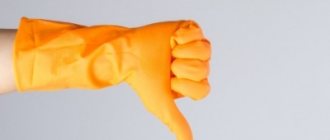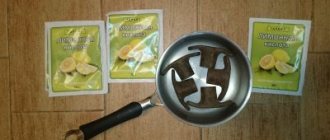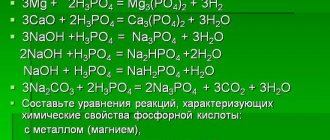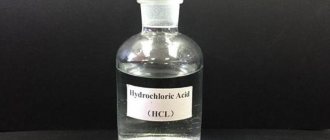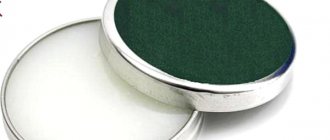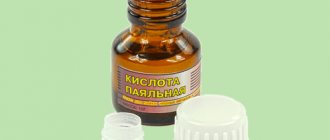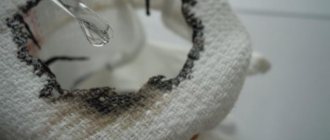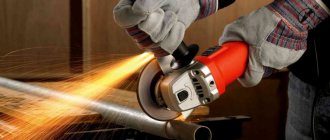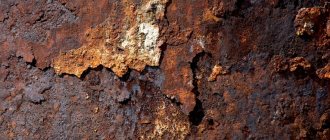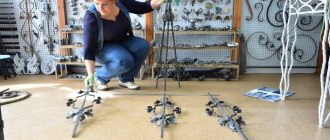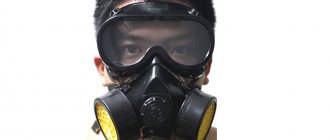Some say that after using the converter everything is bad for them. And others say that everything is fine with them.
The trick is that everyone is right. :))
Let's figure out what these people did.
Some applied the converter and waited for it to work. We cleaned off the accumulated deposits with a hard scourer or simply wiped them with a rag, then degreased the part (what matters here!) and primed it.
Others applied the converter and waited for it to work. We washed it off with water (with or without baking soda, it doesn’t matter), degreased it (what matters!) and primed it.
For both the former and the latter, the result can be either positive or negative. :)))
Magic?! NO! Magic doesn't exist.
Phosphoric acid (namely, it is the main element in the rust converter) dissolves in water, ethanol and other solvents. For those who don’t know, ethanol is banal alcohol.
From here the following follows. Any rust converter based on this acid can be neutralized either with water or any other solvent. Alcohol is also a solvent if so :))
Further, following common logic, everyone knows that if bare metal is poured with water, it will accelerate the formation of rust almost instantly (and it will not necessarily be visible to the naked eye)
This leads to the following: Wash off the rust breaker from bare body metal with water, idiotic!
And this is where we start to get to the magic.
Why is it that some people washed off the part with water and primed it and everything is fine for them, while others who seem to have done the same thing are doing poorly?
And at the same time, for some who did not wash it off, everything can either be good or bad.
And the magic lies in the pre-priming stage. Namely, degreasing the surface.
———- thinner solvent degreaser——
Before painting, as everyone knows, the surface must be degreased.
And here the dancing with the tambourine begins. Which then can become one of the reasons that will lead to misunderstandings with the rust converter.
The fact is that there are DEGREASERS and there are SOLVENTS. Both are designed to clean the surface.
BUT! SOLVENT AND DEGREASER ARE DIFFERENT PRODUCTS. When painting a car, it is a degreaser and not a solvent that is used to clean the surface before painting.
DEGREASER (SO CALLED ANTISILICONE) ACTS DIFFERENTLY THAN SOLVENT.
The difference between them is the same as between a solvent and a thinner. Car paint cannot be diluted with a solvent; for this purpose, a thinner must be used.
———- thinner solvent degreaser
——
*Thinner and degreaser*
THINNER AND DEGREASER
much
less aggressive
than
solvents
and in addition to this, both THINNER AND DEGREASER, unlike
solvents
, DO NOT LEAVE AN OILY RESTRAINT on the surface after they evaporate. There are nuances in the composition itself, but that doesn’t matter anymore.
Acid immersion cleansing
If phosphoric acid is available in sufficient quantities, you can get rid of rust by immersing the part in it. Before doing this, you need to completely degrease the damaged item, and then wash off traces of the degreaser. The cleaned part must be neutralized from the action of acids, so it is treated with a solution of alcohol and water with the addition of ammonia.
Then the part must be thoroughly dried. All actions in this process have their own production necessity. If you immerse an unprepared part in phosphoric acid, the etching will be uneven. If the part is not dried, for example by convection, hydroxide will appear on the surface.
Precautionary measures
When working with any acids, the most important thing is your own safety. Phosphoric acid is no exception. Before using it, you need to make sure you have a prepared respirator and rubber gloves. After all, phosphoric acid is a rather dangerous chemical that causes skin burns. The fumes of this acid are no less dangerous: their action can lead to severe poisoning or burns of the respiratory tract. It is also worth remembering that phosphoric acid is highly flammable and can lead to a fire. It is for these reasons that most activities with this substance should be carried out outdoors or in well-ventilated rooms. The main thing is not to let the acid get on the skin, but if this does happen, you should immediately wash the affected area under running water. If a significant part of the skin has been exposed to a chemical burn, you should immediately consult a doctor.
How to defeat scale? Advice from experienced housewives
To remove rust and scale at home, use a weak solution of phosphoric acid. It turns rust into a black coating, which can then be easily cleaned from a metal product. Orthophosphoric acid is also indispensable for removing scale from dishes.
Step-by-step instructions for making a rust converter with your own hands
Products called “Rust Converter” help solve the problem of corrosion of metal products.
Today there is a wide range of such chemicals on sale. However, the issue of making anti-rust products on their own is of interest to many.
Having decided to use a homemade converter, you must follow the recipe and technology for its use. At the same time, it is worth remembering all the pros and cons of such a product, as well as precautions when using it.
We'll tell you how to make a rust converter with your own hands at home in this article.
Expert advice
You need to clean areas of rust very carefully so that no holes appear and the metal does not become too thin. It is not recommended to use discs with very large abrasive particles during work, as instead of removing rust, they can cause more harm than good.
Before starting all repair work to remove rust, you must remember that this product is very powerful and strong. After all, it can remove not only the rust itself, but also the decorative coating: chrome, zinc. Therefore, it is necessary to process car parts very carefully and carefully so that you do not have to spend money on new spare parts in the future.
If all work to remove rust using phosphoric acid was carried out in accordance with all standards, then the resulting surface will be durable and reliable. And although the use of converters is considered the most popular method for body work, we should not forget about other options known to craftsmen.
A little converter is applied to a surface cleaned of a thick layer of rust and left for a couple of minutes or hours, depending on the concentration of the solution, and then further repair work begins.
Previous MaterialsUsing camouflage vinyl film for a car Next MaterialsThe best anti-corrosion agent for a car today: rating of anti-corrosion body treatment products
Can citric or acetic acid be used to lower pH?
It is possible, but it is not necessary, because it is completely ineffective. The fact is that citric and acetic acids belong to the category of weak organic acids, the ions of which serve as food for microorganisms living in the solution. Therefore, despite the fact that these acids do lower the pH of the solution, the change will not be sustainable: the fungi and bacteria inhabiting the solution will quickly eat the citrate / acetate ions formed as a result of the breakdown of these acids, and after a few hours the pH will return to its previous (higher) value.
Removing paint and rust
Cleaning metal from corrosion and old paint layers can be done in three ways:
- chemical;
- mechanical;
- thermal.
Mechanical method
This method, considered the most effective, involves removing rust and paint manually or using a power tool. Processing can be performed:
- wire brushes;
- grinding discs;
- using a sandblasting unit;
- by waterjet method (performed only in industrial enterprises).
Chemical treatment
Chemical treatment is based on the effect of chemical substances sprayed on the surface or applied with a brush to rust.
Rust removing compounds are divided into two types:
- washable;
- indelible.
The disadvantage of wash-off products is the likelihood of new foci of corrosion appearing on the metal, therefore after treatment the surface must be immediately dried and treated with anti-corrosion compounds.
When treating rust with indelible compounds, a chemical reaction results in the formation of a kind of primer layer on the metal surface that cannot be washed off with water.
Processing of metal structures is most often performed:
- a solution of sulfuric or hydrochloric acid (5%) with the addition of a corrosion inhibitor;
- orthophosphoric acid (15-30% essence), which converts rust into a protective coating;
- mixture 50 gr. hydroxypropionic acid per 100 ml of petroleum jelly, under the influence of which rust turns into salt and is easily cleaned from the surface with a rag.
Thermal method
Removing paint from metal surfaces using the thermal method involves using a blowtorch. The metal is heated until the paint coating gradually peels off, which can be easily removed with a spatula or a metal brush.
The main advantage of this method is significant time savings, but the main disadvantage is a fire hazard and some restrictions on the types of surfaces. It is impossible to process sheet and galvanized material, cast iron using this method - the surface is deformed and the integrity of the structures is compromised.
Choosing paint
The next question we will face is: what paint to choose? At the moment, the most popular types of paint are:
Oily. These drying oil-based paints are well suited for interior work, but it is better not to use them for exterior work. Oil paint quickly fades, cracks, offers little protection against rust and cannot withstand heating above 80 degrees.
Alkyd. These paints adhere most firmly to the surface, which is why they are often used for galvanized metal. But like the previous ones, oil paints cannot withstand high temperatures and are also flammable.
Acrylic. These paints are suitable for both exterior and interior use. They are durable, environmentally friendly, do not fade and are fireproof. The advantages include resistance to high temperatures, as a result of which the paint can be used for heating radiators.
Epoxy paints can also be distinguished, but they are not used in everyday life because they are very toxic.
If our main goal when painting is to protect the metal from corrosion, it is worth choosing a paint that contains special anti-corrosion additives. Such paints will cost more, but their effectiveness is higher.
Phosphating methods
The formation of a phosphate protective film on a metal surface is achieved in several ways, the possibility and feasibility of which depends on the size of the structure and its area of application.
The most commonly used methods are:
- surface treatment with Majef, which is allowed even for low-carbon steel, resulting in the formation of a high-quality primer with anti-corrosion properties;
- the use of phosphoric acid or “cold phosphating”, in which the thickness of the protection is no more than 5 microns;
- the use of zinc monophosphate, which is used primarily in the mechanical engineering and electrical power industries;
- treatment with phosphating paste.
To prepare metal for painting, it is necessary to perform a number of mandatory procedures, without which high-quality painting and, accordingly, long-term operation of metal structures are impossible.
You may also be interested in knowing which metal fence paint is best for your situation. Read about this in the article about painting metal fences.
Pros and cons of cleaning
Phosphoric acid is a popular and sought-after rust remover.
This is due to several advantages of the reagent:
- high cleaning efficiency;
- ease of use;
- budget cost;
- wide scope of application.
However, when using this inorganic substance, a number of negative aspects are revealed. The existing disadvantages limit the use of the converter and force one to remember precautions.
The most important disadvantages are:
- Acid and its vapors can irritate mucous membranes, respiratory tract, and eyes.
- If a pure substance accidentally enters the stomach, nausea, vomiting, and diarrhea occur.
- Possible appearance of holes when cleaning very thin products from rust.
- Cannot be used to remove rust from objects coated with acrylic.
Phosphating of metal surfaces
Phosphating is the process of coating the surfaces of ferrous or non-ferrous metals with a thin film that protects it from rust formation and improves adhesion to the paint composition.
The use of this technology can significantly improve the wear resistance of contacting parts in friction units. The method can be implemented for almost all alloys, except for high-alloy steel - a phosphate film of insufficiently high quality appears on it.
Why is phosphating performed?
Phosphating of metal before painting is carried out in order to provide the surface with reliable protection from corrosion processes in places that have been mechanically cleaned of old paint and rust. Before applying a protective layer, metal structures or products must be thoroughly cleaned of dust and dirt, and also degreased.
This method of protecting metal structures allows their operation in the following conditions:
- exposure to automobile oils and fuels;
- in electrical installations up to 1 kV;
- high humidity;
- in environments with organic solvents;
- being under paintwork.
The resulting film is capable of reliably protecting the metal under the above conditions, but is quickly destroyed in aggressive acidic and alkaline environments. Therefore, before performing phosphating, it is necessary to determine the composition of the environment in which the metal product will be used.
How does it work
The process is simple. You buy a converter; it usually comes in spray cans. Next, it is sprayed onto the site of the outbreak, then it is advisable for us to leave this place for about half an hour - an hour.
The product does not remove rust at all, if I may put it roughly, it freezes it and prevents it from spreading further. An iron phosphate film forms on the affected surface, which is a protective element. The work period is approximately one to two years, then it is advisable to repeat the procedure.
I would like to note from personal experience that my uncle is a minibus taxi driver and works on his minibus almost every season before winter. And you know, it really rots less when compared with untreated neighboring cars along the route.
But we are wondering whether it is possible to produce it with our own hands, what is the approximate composition. I’ll say right away that there are two compositions, the one that is used in production, and the one that is made at home.
Metal degreasing
Degreasing of structures is carried out to ensure good adhesion of the metal with the paint and varnish composition and primer.
To degrease metal before painting, in principle, you can use any composition that removes organic substances and fats. But still, it is better to use complex compounds that convert rust into a useful layer and prevent its appearance in the future:
- White Spirit;
- numbered nitro solvents;
- degreaser with complex alcohols;
- kerosene.
It is not recommended to use gasoline as a degreasing agent, since as a result of its exposure, an invisible oil film appears on the surface, which impairs adhesion to the paint.
Degreasing must be carried out in well-ventilated areas with constant air circulation, since the vapors of most chemicals used are very toxic. To avoid poisoning, it is recommended to wear a respirator, work in rubber gloves and safety glasses - if any solvent gets into the eyes, a chemical burn to the mucous membrane cannot be avoided.
Areas of use
Phosphoric acid and its derivatives have found wide application in a wide variety of areas of human life. Among the main directions are:
- Production of simple phosphorus (superphosphate and phosphate rock), complex and complex mixed fertilizers.
- The use of feed phosphates as one of the important additives in agriculture makes it possible to increase the average daily weight gain in pigs and bulls, and increase milk productivity and egg production.
- Esters and salts are widely used in the manufacture of additives for water softening and synthetic detergents, and are part of surfactants in the manufacture of cement. They bind calcium and magnesium ions, which are responsible for hardness and worsen the quality of washing.
- In foundry production and metalworking, orthophosphoric acid has been used for rust - for phosphating, as a flux for soldering on stainless steel, ferrous metals and oxidized copper, for polishing and cleaning surfaces.
- In the textile industry - for fire-retardant impregnation and dyeing of wool and leather, natural and synthetic fibers.
- In chemical production, it serves as a catalyst for organic synthesis and raw material for reagents.
- In the aerospace field, its esters are components of the hydraulic fluid of aircraft engines and rocket fuel deicers.
- In the mining and oil industries, sodium phosphates are used to enrich ores and prepare drilling slurries.
- In freezing units it is part of freon. It is also used for the manufacture of various brands of special glasses, including optical glasses, ceramics and porcelain, photosensitive emulsions for photographic paper and film.
- In the production of refractories, phosphates serve as fillers for refractory concrete, raw materials for phosphorus wood boards and non-combustible foam, fire-resistant paints and materials (varnishes, paints, enamels, primers and impregnations).
- In medicine, its solutions are used to prevent urolithiasis and stomach problems. In dentistry, it is used for the manufacture of cements, compositions for etching tooth enamel and treating the internal surfaces of crowns.
- The woodworking industry has found application in the fact that impregnation with phosphoric acid makes the material non-flammable - it imparts fire resistance. For example, when making matches, aspen sticks are impregnated with a 1.5% solution to prevent smoldering.
- In the food industry, the E338 additive regulates acidity, increases shelf life, preserves flavor characteristics and enhances the effect of antioxidants. It is widely used in baking powders, processed cheeses, carbonated drinks, baby formula, marmalade and cakes, sausage production and sugar production.
Removing rust
It is better to start treating metal with orthophosphoric acid with mechanical intervention. It is recommended to clean large objects with a metal brush or grinder. Small parts can be sanded with sandpaper. After cleaning the item to be restored, degrease the surface. What other recommendations are there:
- after treatment with the product, be sure to wash off the acid;
- do not use the chemical on food products: this is only allowed if you completely remove any remaining acid;
- At the end of etching, make sure the item is processed and dried.
We offer you for review several methods of acid cleaning: the immersion method and the application method.
Method of total processing of metal parts
This option is suitable for parts that can be easily loaded into a tank. For example: metal tools, small parts, coins, antiques and all kinds of fasteners. Let's move on to the work in detail:
- take your item and wash it with soapy water, dry it and degrease it;
- find a deep reservoir and pour phosphoric acid into it - 150 grams of 85% product per liter of water;
- put the part in the solution for about a couple of hours;
- remove the item and rinse thoroughly with running water;
- make a solution with 50% water, 48% regular and 2% ammonia;
- Rinse the parts with the solution and dry completely.
Rules for transporting acid
Acid can be transported with strict adherence to the following precautions:
- the packaging must be chemically inert (preferably plastic - glass cannot ensure safety during transportation due to its fragility);
- the container must prevent spilling or evaporation of the liquid preparation or scattering of crystals;
- It is necessary to exclude the possibility of foreign moisture or dust getting inside the package.
Important! Safety signs must be placed on the outside of the container.
